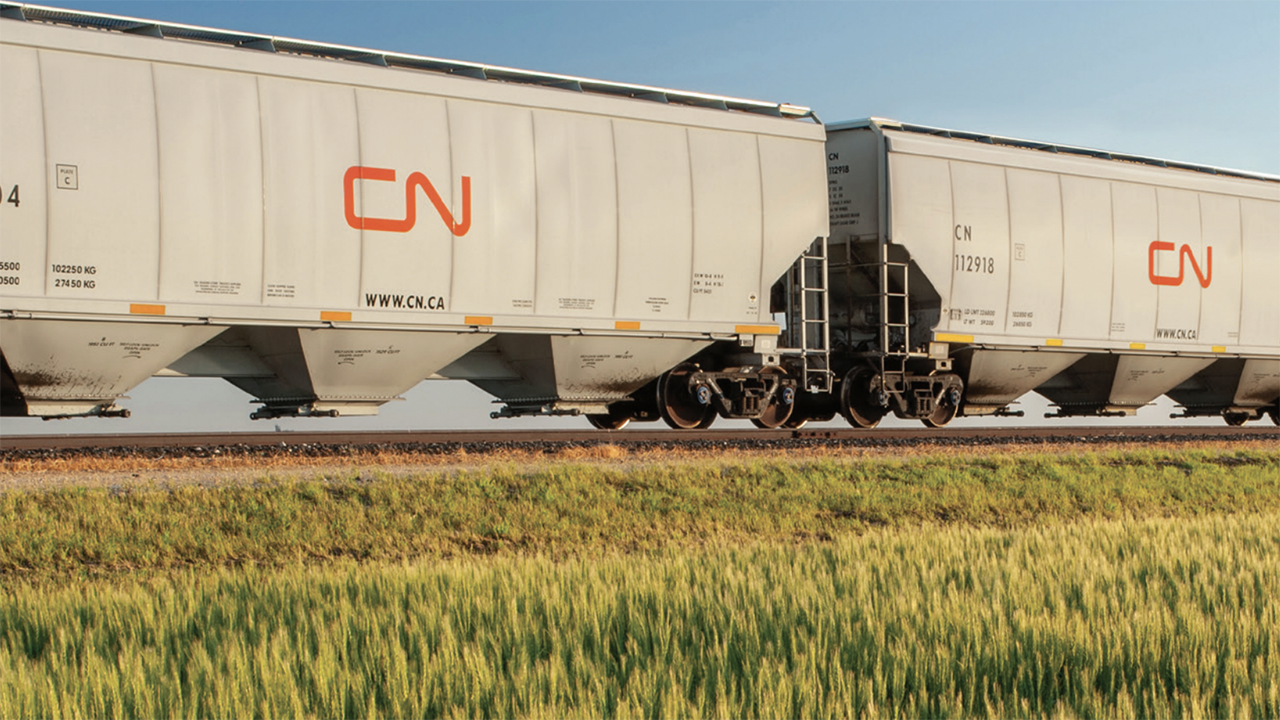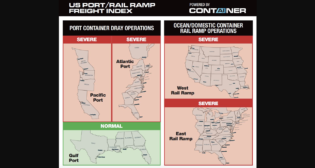
CN Releases 2023-24 Grain Plan
Written by Marybeth Luczak, Executive Editor
“We at CN know that Canada’s agricultural industry has always been the cornerstone of our nation’s economy, contributing significantly to its growth and stability,” CN President and CEO Tracy Robinson said upon release of the Class I’s 2023-24 Grain Plan. “Through the collaborative efforts of CN and our supply chain partners, we aim to optimize the movement of agricultural goods efficiently and sustainably.” (CN Photograph)
As required by the government of Canada, CN has published an action plan to meet the volume of grain expected to be moved in the 2023-24 crop year.
The new Grain Plan was prepared in coordination with key stakeholders, including the CN Agricultural Advisory Council—a group of western Canadian farmers and industry leaders—and builds on operational improvements of the 2022-23 crop year, CN reported Aug. 1.
The 48-page plan reviews the Class I railroad’s performance during the past crop year; assesses the railroad’s ability to move anticipated levels of grain during the upcoming crop year; and explains specific steps CN is taking to ensure it has the capacity to move grain safely and efficiently on behalf of farmers, customers and supply chain partners.

Among CN’s new actions and initiatives for 2023-24 crop year:
- Refining the scheduled operating plan. Running “to plan” is key, CN said, and the changes it made to operational planning and communication last year “delivered the best train velocity since 2016 along with strong, consistent grain movement.” The railroad will standardize “the improved coordination and execution established between network and field operations this year,” it reported.
- Rolling stock acquisition. CN said it will take delivery of 750 new high‑efficiency grain hopper cars in 2024.
- Developing and preparing employees. CN’s staff resourcing for 2023-24 will be in line with anticipated customer demand and “account for new government regulations related to personal leave days and sick days that are expected to impact labor availability,” according to the Class I. “CN labor priorities for the year ahead focus on employee retention and encourage collaboration across CN teams.”
- Locomotive initiatives. CN said it will continue process improvements to increase locomotive reliability. Heading into this fall, it expects its inventory of high‑ and mid‑horsepower locomotives to be approximately 1,950. CN had approximately 1,950 high‑ and mid‑horsepower locomotives as of August 2022 and approximately 1,900 high‑ and mid‑horsepower locomotives as of August 2021. CN said its locomotive fleet will include 60 newly acquired Dash‑9s and 30 SD75 locomotives slated for modernization from DC‑ to AC‑traction motors.
- Supply chain score-carding initiatives. “Canada must expand its measurement systems to consider all parts of the grain supply chain,” CN said. “It is also clear that real‑time live information has become critical to maximize the capacity of the supply chain. Government and industry measurement systems should include indicators like grain terminal loading times and customer demand forecasting.”
- Technological innovation. CN said it expects to implement a new Precision Dispatch System “to further optimize train movement” across its network.

Expectations for the 2023-24 Crop Year
“Based on current demand forecasts and the best economic and market information available, CN expects the total demand for rail service between Edmonton and Jasper, AB, and between Jasper, AB, and Vancouver, BC, to exceed capacity at times during the fall of 2023 and early into 2024,” the railroad reported. “CN expects total demand for rail service to be at or below capacity for the same period on the BC North corridor between Jasper, AB, and Prince Rupert, BC.
“The expectation that the railway has capacity available and ready, wherever and whenever required, must be balanced against the fact that there will always be limited capacity to respond to demand shocks driven by sudden changes in market conditions or significant global events. Capacity is not infinite, and CN and our customers must plan together and prepare for the future to the best of our respective abilities. Customers across all CN business segments have knowledge critical to CN’s resource planning. To that end, frequent and open communications ensure customer forecasts and resource updates are shared and CN can better adjust to the uncertainties that impact markets and demand.
“Making the most efficient use of the capacity available in all rail corridors throughout the year means more farmers’ grain getting to market in a timely fashion. That supports farmers’ cash flow and marketing activities. For example, the eastern Canadian transportation system is significantly underutilized and represents an opportunity to increase shipment volumes of grain and other commodities, especially during peak period demand for grain movement through the fall and winter. Corridor balance is required to maximize supply chain capacity and throughput.”
According to CN, on an annualized basis, grain supply chain capacity of up to 36 million metric tons (MMT) via carload on the Class I is available for the 2023-24 crop year, “assuming all the conditions are in place to achieve maximum sustainable supply chain capacity.” Based on current Agriculture and Agri‑Food Canada estimates of total available supplies, the volume of grain and processed grain products offered to CN by customers for movement via carload over the 2023-24 crop year is projected to be 25.0 MMT to 27.5 MMT, with grain shipped via container direct from Western Canada in addition to these volumes, according to the railroad. While experience shows that “forecasts may not always reflect reality,” CN said it will “refine our assessment of anticipated volumes to be moved based on overall crop production and other market factors sourced in part from information collected by grain customers and other industry stakeholders.
“Containerized grain shipments direct from Western Canada are an important means of getting grain from the Prairies to domestic and overseas markets … CN moved over 0.8 MMT of grain direct from the Prairies via container during the 2022-23 crop year. CN expects that containerized grain shipments direct from Western Canada will continue to represent a significant volume of grain shipments in the upcoming crop year.”
With the “right conditions,” CN reported, it “will be able to deliver strong performance for the upcoming harvest and beyond.” During the 2023-24 crop year, CN said it is “well positioned to ship up to 7,800 cars per week (up to 744,000 metric tons per week) of grain and processed grain products outside of winter, and up to 6,250 cars per week (up to 595,000 metric tons per week) of grain and processed grain products during winter, assuming all the conditions required to meet these levels across the end‑to‑end supply chain are in place, including demand balance across corridors.”
While CN “believes we have the resources in place to move this year’s harvest” and “there is potential to build on the records set for grain movement during the 2022-23 crop year,” the railroad reported that it “remains concerned about the negative supply chain capacity consequences of extended interswitching and continued rain delays in loading grain vessels at the Port of Vancouver.”
Summed up CN President and CEO Tracy Robinson: “We at CN know that Canada’s agricultural industry has always been the cornerstone of our nation’s economy, contributing significantly to its growth and stability. Through the collaborative efforts of CN and our supply chain partners, we aim to optimize the movement of agricultural goods efficiently and sustainably. Together, we can navigate the challenges ahead, capitalize on new opportunities, and ensure the continued success and prosperity of the Canadian agricultural sector.”



